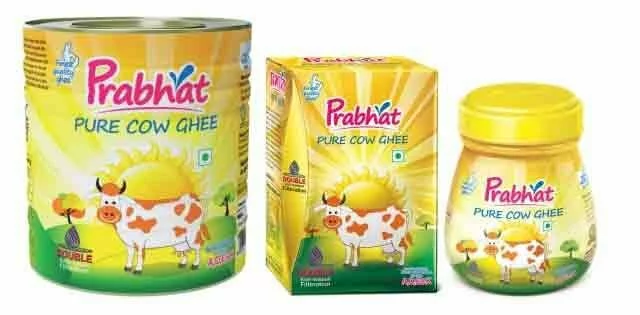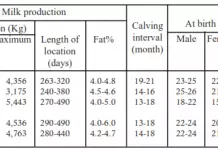INTRODUCTION TO THE NEW ZEALAND DAIRY INDUSTRY
The dairy industry in New Zealand earns just under 20% (or about $4 billion) of the countryís export income and thus is a major contributor to New Zealandís economy.
About 95% of the milk produced by the countryís 2.9 million dairy cows is manufactured by 12 co-operative dairy companies into processed dairy products such as butter, cheese, milk powders, nutritional products and infant foods, casein and whey products and lactose.
The remaining milk meets New Zealandís domestic requirements for liquid milk products, for example whole milk, skim milk, trim milk and fresh cream, together with yoghurt and cottage cheese. In the 1995-96 season, the average New Zealanderís consumption of milk products was just over 8 kg butter, about 9 kg cheese and 91 L milk. Although New Zealand produces less than 2% of the worldís milk, it is a major player in world trade, as the countryís dairy exports amount to about one quarter of the international trade in dairy products.
Milk contains a very wide range of essential nutrients. The major components in New Zealand cowsí milk are carbohydrates, mostly lactose (4.5-5%), fats (mean 4.6-4.7%), proteins (caseins (about 2.8%) and whey proteins (about 0.7%)), minerals (0.7%) and vitamins (0.15%), the remainder being water.
PRODUCTION AND TRADE
The New Zealand dairy industry is a major contributor to the economy of this country. In the 1995/96 trade year, exports of dairy products earned New Zealand $3.8 billion, equivalent to
18.5% of its total export earnings of about $20.5 billion. In the 1996/97 year, dairy product exports earned $4.4 billion (Hall, 1997).
New Zealand has approximately 2.9 million dairy cows (nearly one per person), the number having grown steadily from 2.2 million in 1983/84. At present, 95-96% of their total milk production is used in the manufacture of processed dairy products, the remainder being used to meet domestic (New Zealand) requirements for liquid milk products. The amount of milk
produced in New Zealand and the size of its dairy industry are shown in Table 1.
Because of the relatively small population in New Zealand, the domestic consumption of milk and fresh milk products (such as whole milk, skim milk, trim milk and fresh cream,together with yoghurt and cottage cheese) accounts for only a small proportion (4.6%) of the total output of the dairy industry, as indicated above. Actual consumption of milk and the main dairy products is shown in Table 2.
About 86% of New Zealand’s milk is produced in the North Island, and half of that comes from the South Auckland-Waikato region. Approximately 17% of the country’s milk is
produced in Taranaki.
In October 1997 milk was processed by 12 co-operative dairy companies – four in the North Island and eight in the South Island. The largest co-operative was the New Zealand Dairy Group (approximately 50% of all manufacturing milk). Other major companies were Kiwi Co-operative Dairies (Hawera) (26.9%) and Northland Co-operative Dairy Company Ltd (Whangarei) (9.9% of all manufacturing milk). The amount of dairy products made in New Zealand in 1995/96, together with the volume and value of New Zealand’s dairy exports for that period, are shown in Table 3
International trade in dairy products accounts for only some 5% of the estimated 527 million
III-Dairy-A-Introduction-4 tonnes of milk produced throughout the world. Although New Zealand produces less than 2% of that milk, it is a major player in the international trading of dairy products, in which it accounts for about 24% of the world’s exports, as shown in Table 4.
Whole milk contains a very wide range of essential nutrients. A typical composition for manufacturing milk is shown in Figures 1 and 2. This is higher in milk solids than the milk shown in Table 5 which is produced for domestic (New Zealand) consumption from herds consisting mainly of Friesian cows. Manufacturing milk, on the other hand, is produced from both Friesian cows and Jersey cows and the milk from Jersey cows has a higher solids content than that from Friesian cows.
COMPOSITION AND PROPERTIES OF MILK
In very simplified terms, milk is an emulsion of the fat (cream) in skim milk. Skim milk is a colloidal suspension of micelles or very tiny particles composed mainly of casein (protein), calcium and phosphate, with soluble protein, carbohydrate and minerals dissolved in the water. Thus, butter made from cream is mainly fat, cheese made from whole milk is rich in both protein and fat, casein made from skim milk is mainly protein, and the solids in the whey from these two last-named product groups consist mainly of carbohydrate. The composition of milk is described in more detail below, and the later articles describe the main processes used and the products manufactured in the New Zealand dairy industry, as outlined in Figure 3. Table 5 shows the quantities of certain nutritive components in various milk products.
THE MAJOR COMPONENTS OF COW’S MILK
Carbohydrates
The main carbohydrate in milk is the disaccharide, lactose. It is important in the manufacture of cheese and lactic acid casein. Lactose can be fermented by lactic acid-producing bacteria (known in the dairy industry as ìstarterî or ìstarter bacteriaî) to produce lactic acid in accordance with the simple reaction shown below: C12H22O11 + H2O 4 CH3CH(OH)COOH In this fermentation, the pH of the milk is reduced as the acidity (as lactic acid) increases. Both cheese and lactic acid casein contain all the casein protein, and the watery by-product of the manufacture of these two classes of dairy products is whey. The principal component in whey from cheese and casein (after water) is still lactose (4.5-5%) as only a small proportion of the total lactose in milk is utilised in the fermentation mentioned above. As noted in more detail in the articles on lactose and whey products, whey is used in the manufacture of lactose, in ethanol production, for use in baby foods and for the manufacture of whey powder.
Fats (or lipids)
Milkfat consists mainly of triglycerides, esters of glycerol and three of about 20 carboxylic acids (fatty acids):
where R1, R2 and R3 represent the hydrocarbon chains of the different fatty acids. Compared with vegetable oils, the fatty acids in milkfat have a fairly low degree of unsaturation and are relatively high in the proportion of short chain (C4-C10) acids. Because of this low degree of unsaturation, milk fats are less readily autoxidised and keep better than vegetable oils. Lipolysis, the enzymatic hydrolysis of triglyceride to give free fatty acids, causes lipolytic rancidity, with butanoic acid especially providing much of the sharp taste of rancid butter. This reaction is important in the production of cheeses such as Blue Vein, Provolone and Parmesan.
Phospholipids are also important. They are surface-active compounds and are found mainly in the fat globule membrane in products such as milk and cream where they stabilise the oilin-water emulsion. Lecithin is an example of this class of compound. It has the following structure:
Proteins
The two major classes of milk proteins are the caseins and the whey (serum) proteins. 1 Caseins exist in milk as colloidal suspensions of micelles (clusters of casein molecules associated with calcium and inorganic phosphate). These give the milk its white appearance, as the micelles are large enough (20-200 nm) to scatter (reflect) light. There are several different caseins – αs1-, αs2-, β- and κ-casein, so-called according to their behaviour during electrophoresis (i.e. movement in an electric field).
The αs- and β-caseins generally consist of about 200 amino acid residues and have a molecular weight of 23 000 – 25 000, whereas κ-casein has somewhat fewer residues and a consequently lower molecular weight. κ-Casein is believed to be located on the surface of the micelles, where it provides a tabilising effect in the milk system. In milk, the micelles carry a net negative charge which is important for maintaining their stability. A reduction in the pH (increasing the acidity) or addition of chymosin (a milk-clotting enzyme) decreases this charge, causing precipitation of the casein or coagulation of the milk. This forms the basis of the industrial production of casein.
Caseins contain a higher percentage of (organically bound) phosphorus than most proteins and are consequently considered to be phospho-proteins. 2 Whey (serum) proteins, in contrast to caseins, are soluble, and do not precipitate under conditions that cause the caseins to precipitate.
They are rich in the superconducting amino acids (cysteine and methionine), and are not chemically combined in milk or whey with either phosphorus or calcium. Minerals Metal ions present in milk in significant concentrations are Ca2+, K+ , Na+ and Mg2+. About 70% of the calcium in the milk is bound to casein in the micelles (in a colloidal form), together with a similar proportion of the inorganic phosphate in the milk. Most of the remaining calcium is bound to inorganic phosphate.
The non-colloidal calcium is present either as dissolved salts (mainly with inorganic phosphate) or in an ionic form. Inorganic phosphate accounts for two-thirds of the total phosphorus content, the remainder being organically bound phosphate in casein or phospholipids. Vitamins Milk contains a number of important vitamins, e.g. vitamins B1 (thiamine), B2 (riboflavin) and niacin, that are soluble in water, and the fat-soluble vitamins A and E (tocopherols).
REFERENCES
Enterprise New Zealand Trust (1992)
The New Zealand Dairy Industry. Enterprise New Zealand Trust, Wellington.
Hall T (1997)
Dairy Board reports record earnings. The Dominion newspaper, Friday 11 July 1997, p. 19.
International Dairy Federation (1996)
The World Dairy Situation 1996. Bulletin of the International Dairy Federation, No. 314.
International Dairy Federation, Brussels.
McLaren, A. (1997)
Consumption of ice cream, yoghurt and fresh cream. Fax from Statistics New Zealand,
Wellington, dated 9 September 1997.
New Zealand Dairy Board (1997)
Dairy Facts and Figures 1995/96. New Zealand Dairy Board, Wellington.
Population Reference Bureau (1997)
1997 World Population Data Sheet (via Internet: http://www.prb.org/prb/info/97wpds.htm).
Population Reference Bureau, Washington, DC.
Statistics New Zealand (1997)
Key Statistics (selected data) [June issue, 1997].
Visser F V, Gray I K & Williams M M F (1991)
Composition of New Zealand Foods. 3. Dairy Products. Department of Scientific and
Industrial Research, Palmerston North; and New Zealand Dairy Board, Wellington.
Written by C. R. Southward (Consumer and Applications Science Section) and L. K.
Creamer (Food Science Section), New Zealand Dairy Research Institute.
Source : nzic
Comments
comments




















